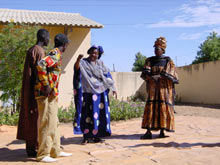 |
EDUCATION AND TRAINING, in detail
|
 |
 |
 |
 |
 |
|
|
 |
Insufficient schooling, or worse, lack of access to school education is one of the single most limiting factors in life, preventing people to develop and use their full potential. This human deprivation also limits people’s ability to find a job, to access well-remunerated employment, or to develop some of their entrepreneurial skills, and is therefore one of the main causes of income poverty. Those who are illiterate are doubly disadvantaged, as they can less easily improve their skills or know where and how to look for remunerated activities. Vice versa, poverty often precludes children from going to school, forces many of them to work to survive or to increase the family's income, and hampers many people’s access to adequate education - thus fuelling a vicious circle that makes it hard to uplift oneself out of poverty.
|
|
|
Inadequacy between jobs offered and people’s qualification is one of the causes of unemployment and under-employment. In rural areas, insufficient access to education and to information makes it difficult for poor people to manage agricultural production in a sound way. This may result in lower income and loss of yielding capacity. It may also be a major obstacle to an optimal commercialisation of their products with negative consequences on income. Where children are in school, but are underfed or malnourished, they do not draw full benefit from their education, as it is difficult to concentrate and follow lessons.
Where communities are too poor, as well as where local or national governments do not have sufficient resources, the school structures may not exist or be inadequate, pedagogical material may be lacking, furniture or stationary may be insufficient, modern technology often non-existent, classrooms overfilled, and teachers insufficiently trained or paid. All these elements are detrimental to the education of the community members. Lack of resources also hampers the development of vocational training, thus depriving people of opportunities. Moreover, distance sometimes makes the existing schools and vocational training centres unavailable to children from suburbs, slums, and poor rural areas.
|
|
 In some places, good schools are private, thus discriminatory to poor people. Poverty also precludes many from accessing higher levels of education. Lack of education or insufficient levels of education can also lead to social exclusion. Moreover, insufficient education and lack of access to information make it difficult for millions of people throughout the world to understand how to prevent and cure diseases or take care of dental health. Education for women and girls helps reduce birth rates, improve the family health and impacts strongly on the family income and use of resources. In some places, good schools are private, thus discriminatory to poor people. Poverty also precludes many from accessing higher levels of education. Lack of education or insufficient levels of education can also lead to social exclusion. Moreover, insufficient education and lack of access to information make it difficult for millions of people throughout the world to understand how to prevent and cure diseases or take care of dental health. Education for women and girls helps reduce birth rates, improve the family health and impacts strongly on the family income and use of resources.
|
|
 Insufficient education also prevents lots of people from knowing their rights or the benefits to which they are entitled. It makes it more difficult to handle any kind of relationship with local or national administrations, to obtain loans from a credit institution, or to resist all sorts of abuses. Insufficient education also makes it more difficult to analyse information given by the media and political rhetoric. It hampers access to modern information technology, thus widening national and international gaps. Insufficient education also prevents lots of people from knowing their rights or the benefits to which they are entitled. It makes it more difficult to handle any kind of relationship with local or national administrations, to obtain loans from a credit institution, or to resist all sorts of abuses. Insufficient education also makes it more difficult to analyse information given by the media and political rhetoric. It hampers access to modern information technology, thus widening national and international gaps.
|
|
Literacy programmes, universal access to primary education, and vocational training are at the heart of any strategy to eliminate poverty. Public and private resources must be mobilised to build, enhance and maintain a solid educational infrastructure. This entails an adequate network of schools and training centres, adequate furniture, stationary and pedagogical material, training of teachers, state institutions capable of managing a good national education system, resources to maintain infrastructures and to remunerate educators.
In some places, complementary nutritional programmes for poor pupils, free transportation to school, free supply of educational material, fellowships for pupils and students, and other financial subsidies to families may be a must. It is also important to ensure that schools in developing countries and poor areas in industrial countries be properly equipped in modern information technology devices to avoid a widening of gaps and opportunities. Special attention must be paid to reducing the gender gap in education.
|
|
|
 |
|
